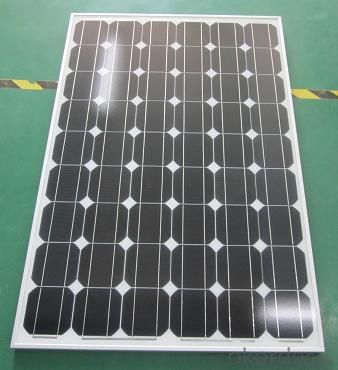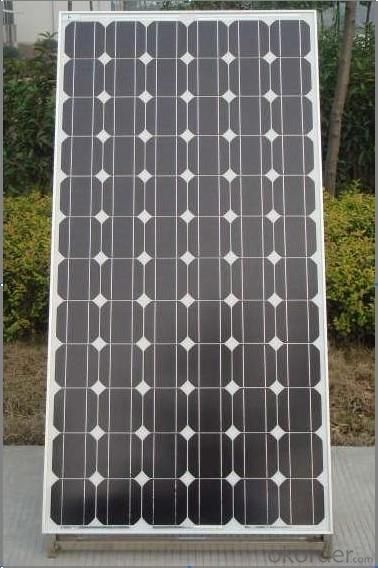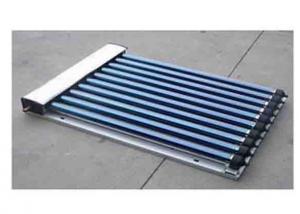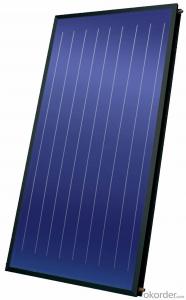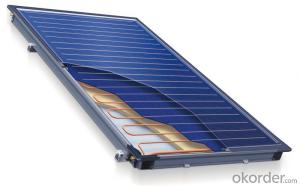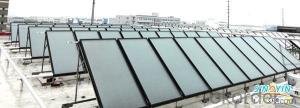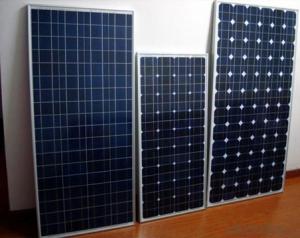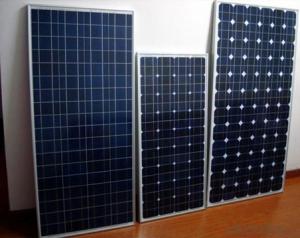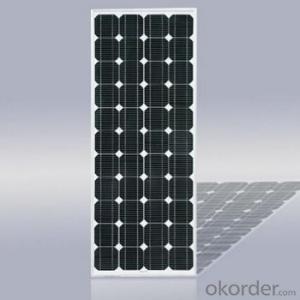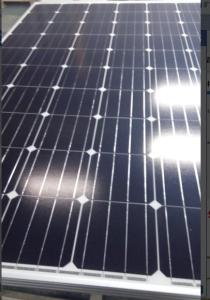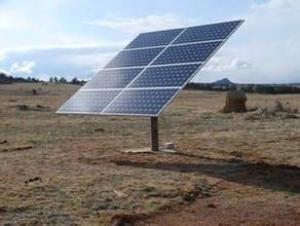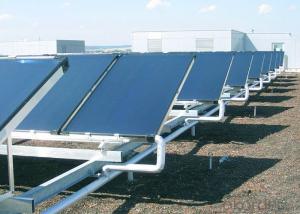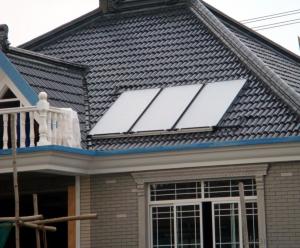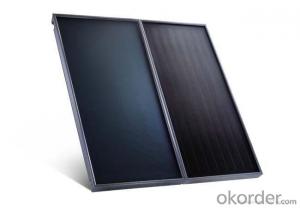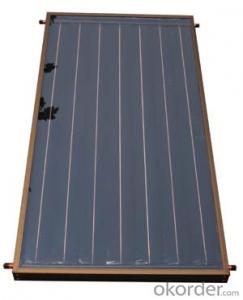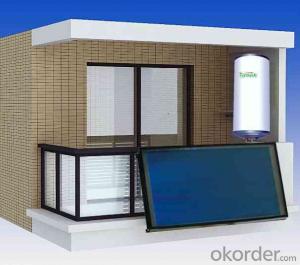Sunearth Solar Collectors - CNBM Brand Solar Monocrystalline Series Panel
- Loading Port:
- Tianjin
- Payment Terms:
- TT OR LC
- Min Order Qty:
- 1 pallet
- Supply Capability:
- 100000000 pallet/month
OKorder Service Pledge
OKorder Financial Service
You Might Also Like
Solar Monocrystalline Series Panels

Product Description:
Introduction of Solar Monocrystalline Series Panels
CNBM Solar photovoltaic (PV) Panel is designed for large electrical power requirements. It is the optimal choice for both on-grid and off-grid power systems. CNBM Solar panel offers high performance of power per square foot of solar array. Monocrystalline silicon(c-Si): often made using the Czochralski process. Single-crystal wafer cells tend to be expensive, and because they are cut from cylindrical ingots, do not completely cover a square solar cell module without a substantial waste of refined silicon. Hence most c-Si panels have uncovered gaps at the four corners of the cells.
Characteristics of Solar Monocrystalline Series Panels
I Solar Cell : High efficiency crystalline solar cell. Even if under the weak light, the solar module can produce maximum power output.
II Tempered glass (toughened glass): Anti-reflecting coating and high transmission rate glass increase the power output and mechanical strength of solar module.
III EVA and TPT: Using high quality EVA and TPT to prevent destroying and water.
IV AI frame: Without screw, corner connection. 6 holes on the frame can be installed easily.
V Junction box: Multi function junction box with water proof.
VI Long lifetime: ≥25 years; Less power decrease
VII Good performance of preventing from atrocious weather such as wind and hails.
VIII Resisting moisture and etching effectively, not effected by geology.
Standard Test Conditions of Solar Monocrystalline Series Panels
The opto-electrical specifications shown below are stabilized values being measured at Standard Test Conditions, Irradiance: 1000W/m2, Spectrum: AM1.5 at 25°C, The info below is subject to manufacturing tolerances. Where appropriate minutes of measurement are available and are used for the dimensioning of the installation.
Advantages of Solar Monocrystalline Series Panels
• CNBM Solar performance guarantees for 25 years
• 12 years guarantee for workmanship
• Timeliness of delivery
CNBM International Corporation's products including Monocrystalline Solar Panel, Polycrystalline Solar Panel have received and enjoyed famous reputation in many countries and regions in the world .As a solar panel supplier in China, we strive to provide our customers with excellent service, superior products and unmatched value.
Characteristics of Solar Monocrystalline Series Panels
Max Power Voltage Vmp (V) | 18.4V | 17.6V |
Max Power Current Imp (A) | 6.52A | 7.39A |
Open Circuit Voltage Voc (V) | 23.0V | 22.2V |
Short Circuit Current Isc (A) | 6.97A | 7.90A |
Max Power Pm (W) | 120W | 130W |
Temperature Coefficient of Cells
NOCT | 47℃±2℃ |
Temperature Coefficients of Isc (%/℃) | 0.064 |
Temperature Coefficients of Voc (%/℃) | -0.33 |
Temperature Coefficients of Pmp (%/℃) | -0.45 |
Mechanical Data Solar Monocrystalline Series
Power | 120W/130W |
Dimension | 1190/1470×670×30mm |
Weight | 9.5kg/11.7kg |
Tolerance | ±3% |
The dimension of the modules can be changed according to the demand of clients
Limits
Operating Temperature | –40 °C to +85°C |
Storage Temperature | –40 °C to +85°C |
Max System Voltage | 700V |
Guarantee Solar Monocrystalline Series Panels
Products Guarantee | 10 yrs free from defects in materials and workmanship |
Performance Guarantee | No less than 90% within 10yrs and no less than 80% within 25yrs |
Certificates | IEC, ISO, TUV, CE |
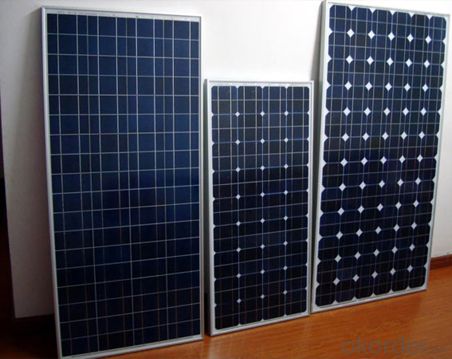
FAQ
I..Will you focus on the safety of the goods during transportation?
Yes, Safety of the cargo is the primary element that we would consider on transportation.
II..How would guarantee the quality will meet the requirements of your clients?
Before shipment, we will have inspection for each batch of goods.
III..What certificates do you have?
IEC,UL,TUV,CSA,etc.
IV..Can you do OEM according to clients’ requirements?
Yes, we have our own brand while we can provide OEM service.

- Q: Are there any limitations to the size of a solar collector installation?
- Yes, there are limitations to the size of a solar collector installation. Some of the key limitations include the availability of suitable space, the capacity of the electrical grid to handle the generated energy, and the cost and efficiency of the system. Additionally, local zoning regulations and building codes may impose restrictions on the size and placement of solar collector installations.
- Q: Can solar collectors be installed on pitched roofs?
- Yes, solar collectors can be installed on pitched roofs. In fact, pitched roofs are often ideal for solar panel installation as they provide a suitable angle for capturing maximum sunlight throughout the day.
- Q: Can solar collectors be used for generating electricity on motorcycles?
- Yes, solar collectors can be used for generating electricity on motorcycles. By installing solar panels or collectors on motorcycles, energy from the sun can be harnessed and converted into electricity to power various components of the motorcycle, such as lights, indicators, or even the motor itself. This renewable energy source can help reduce dependence on traditional fuel sources and contribute to a more sustainable mode of transportation.
- Q: Can solar collectors be used in developing countries?
- Yes, solar collectors can be used in developing countries. In fact, solar energy is particularly suitable for these countries due to its abundance and accessibility. Solar collectors can provide a sustainable and affordable source of energy for various purposes, such as powering homes, schools, hospitals, and businesses. They can help reduce reliance on expensive and unreliable fossil fuels, improve energy access in remote areas, and contribute to the overall development and well-being of communities in developing countries.
- Q: What is the lifespan of the components in a solar collector?
- The lifespan of the components in a solar collector can vary depending on various factors such as the quality of the materials used, proper maintenance and care, and environmental conditions. Typically, the key components of a solar collector include the solar panels, heat exchanger, pump, and controller. Solar panels, which are responsible for capturing sunlight and converting it into usable energy, generally have a lifespan of 20 to 25 years. However, with advancements in technology and improved manufacturing processes, some high-quality solar panels can last even longer, up to 30 years or more. It is important to note that the efficiency of solar panels may degrade over time, resulting in slightly reduced energy output. The heat exchanger, which transfers the heat captured by the solar panels to the desired medium (such as water or air), can typically last between 10 to 20 years. Again, the lifespan may vary based on the quality of the material used and regular maintenance. The pump, responsible for circulating the heat-transfer fluid through the system, generally has a lifespan of around 10 to 15 years. Regular maintenance, such as cleaning and lubrication, can help prolong its lifespan. The controller, which regulates the operation of the solar collector system, can last for 10 to 15 years or more. However, technological advancements and updates may require replacing the controller during the lifespan of the system. It is important to note that these estimates are general guidelines and actual lifespans may vary. Regular maintenance, including cleaning the panels, inspecting for any damage or wear, and addressing any issues promptly, can help extend the lifespan of the components in a solar collector. Additionally, choosing high-quality components from reputable manufacturers can also contribute to a longer lifespan.
- Q: Can solar collectors be used for heating cultural centers and theaters?
- Yes, solar collectors can be used for heating cultural centers and theaters. Solar thermal collectors can capture the sun's energy and convert it into heat, which can then be used to provide heating for indoor spaces. This renewable energy source can effectively contribute to the heating needs of cultural centers and theaters, offering a sustainable and environmentally friendly solution.
- Q: Are solar collectors suitable for residential use?
- Yes, solar collectors are suitable for residential use. They are a cost-effective and sustainable solution for generating clean energy for households. Solar collectors are designed to capture sunlight and convert it into usable electricity or heat, which can be used for various residential purposes such as powering appliances, heating water, or even providing energy for an entire home. They are easy to install, require minimal maintenance, and can significantly reduce energy costs while also reducing carbon emissions and dependence on fossil fuels.
- Q: Are solar collectors compatible with existing heating systems?
- Yes, solar collectors are compatible with existing heating systems. They can be integrated into a variety of heating systems such as radiant floor heating, forced-air systems, and hot water boilers. By supplementing traditional heating sources with solar energy, homeowners can reduce energy costs and decrease their carbon footprint.
- Q: Can solar collectors be used in both residential and commercial applications?
- Yes, solar collectors can be used in both residential and commercial applications. Solar collectors are designed to capture and convert sunlight into usable energy, which can be used to heat water, generate electricity, or provide heating and cooling for buildings. In residential applications, solar collectors can be installed on rooftops or in open spaces to provide hot water or generate electricity for a household's needs. In commercial applications, solar collectors can be used to power various systems and equipment in large buildings, such as offices, hotels, or factories. The versatility and scalability of solar collectors make them suitable for various residential and commercial applications, helping to reduce energy costs and carbon emissions.
- Q: Can solar collectors be used for generating electricity on rooftops in cities?
- Indeed, solar collectors can be utilized in urban areas to produce electricity on rooftops. Also known as solar panels or photovoltaic (PV) panels, solar collectors have the capability to convert sunlight into electrical energy. They can be conveniently mounted on the rooftops of city buildings to harness the copious solar energy available in these locations. Solar panels consist of numerous photovoltaic cells constructed from materials like silicon. When sunlight strikes these cells, it stimulates the electrons within them, resulting in the generation of an electric current. This electricity can then be employed to power a variety of appliances and devices within the building. There are several advantages to installing solar panels on rooftops in cities. Firstly, rooftops provide a spacious area that is often unobstructed by shade or other buildings, ensuring ideal exposure to sunlight. Moreover, the installation of solar panels on rooftops optimizes the utilization of limited space in densely populated urban areas. The generation of electricity through solar collectors on rooftops is an environmentally friendly and renewable energy solution. It diminishes dependence on fossil fuels and reduces greenhouse gas emissions, thus contributing to the battle against climate change. Additionally, rooftop solar installations can enhance the energy independence and resilience of cities, as they generate electricity directly where it is needed. Furthermore, solar collectors on rooftops can yield economic benefits as well. By generating electricity on-site, building owners can reduce their reliance on the power grid and lower their energy expenses. In certain cases, surplus electricity generated can be fed back into the grid, enabling building owners to earn credits or revenue through mechanisms such as net metering or feed-in tariffs. Nevertheless, there are certain factors to consider when installing solar collectors on rooftops in cities. Building codes, structural requirements, and shading issues must be taken into account to ensure the secure and efficient installation of solar panels. Additionally, the initial cost of purchasing and installing solar panels may pose a barrier for some building owners, although the long-term financial advantages usually outweigh the upfront investment. In conclusion, solar collectors can definitely be employed to generate electricity on rooftops in cities. They offer a clean, renewable, and economically viable solution to fulfill the energy needs of urban areas while minimizing environmental impact. With proper planning and installation, rooftop solar installations can serve as valuable assets in the transition towards a more sustainable and energy-efficient future.
Send your message to us
Sunearth Solar Collectors - CNBM Brand Solar Monocrystalline Series Panel
- Loading Port:
- Tianjin
- Payment Terms:
- TT OR LC
- Min Order Qty:
- 1 pallet
- Supply Capability:
- 100000000 pallet/month
OKorder Service Pledge
OKorder Financial Service
Similar products
Hot products
Hot Searches


